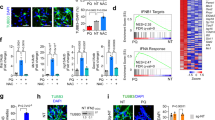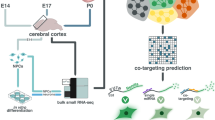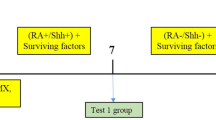Abstract
Forkhead transcription factor family O (FoxO) maintains adult stem cell reserves by supporting their long-term proliferative potential. MicroRNAs (miRs) regulate neuronal stem/progenitor cell (NSPC) proliferation and differentiation during neural development by controlling the expression of a specific set of target genes. In the neurogenic subventricular zone, FoxO1 is specifically expressed in NSPCs and is no longer detected during the transition to neuroblast stage, forming an inverse correlation with miR-9 expression. The 3′-untranslated region of FoxO1 contains a conserved target sequence of miR-9 and FoxO1 expression is coordinated in concert with miR-9 during neuronal differentiation. Our study demonstrates that FoxO1 contributes to NSPC fate decision through its cooperation with the Notch signaling pathway.
Similar content being viewed by others
Log in or create a free account to read this content
Gain free access to this article, as well as selected content from this journal and more on nature.com
or
Abbreviations
- FoxO:
-
Forkhead transcription factor O
- miRs:
-
microRNAs
- NSPC:
-
neural stem/progenitor cells
- SVZ:
-
subventricular zone
- DCX:
-
doublecortin
- GFAP:
-
glial fibrillary acidic protein
- UTR:
-
untranslated regions
References
Ro SH, Liu D, Yeo H, Paik JH . FoxOs in neural stem cell fate decision. Arch Biochem Biophys 2013; 534: 55–63.
Rafalski VA, Brunet A . Energy metabolism in adult neural stem cell fate. Prog Neurobiol 2011; 93: 182–203.
Valencia-Sanchez MA, Liu J, Hannon GJ, Parker R . Control of translation and mRNA degradation by miRNAs and siRNAs. Genes Dev 2006; 20: 515–524.
Ambros V . microRNAs: tiny regulators with great potential. Cell 2001; 107: 823–826.
Stefani G, Slack FJ . Small non-coding RNAs in animal development. Nat Rev Mol Cell Biol 2008; 9: 219–230.
Gao FB . Context-dependent functions of specific microRNAs in neuronal development. Neural Dev 2010; 5: 25.
Liu C, Zhao X . MicroRNAs in adult and embryonic neurogenesis. Neuromolecular Med 2009; 11: 141–152.
Kawahara H, Imai T, Okano H . MicroRNAs in neural stem cells and neurogenesis. Front Neurosci 2012; 6: 30.
Nishino J, Kim I, Chada K, Morrison SJ . Hmga2 promotes neural stem cell self-renewal in young but not old mice by reducing p16Ink4a and p19Arf Expression. Cell 2008; 135: 227–239.
Cheng LC, Pastrana E, Tavazoie M, Doetsch F . miR-124 regulates adult neurogenesis in the subventricular zone stem cell niche. Nat Neurosci 2009; 12: 399–408.
De Pietri, Tonelli D, Pulvers JN, Haffner C, Murchison EP, Hannon GJ, Huttner WB . miRNAs are essential for survival and differentiation of newborn neurons but not for expansion of neural progenitors during early neurogenesis in the mouse embryonic neocortex. Development 2008; 135: 3911–3921.
Smirnova L, Gräfe A, Seiler A, Schumacher S, Nitsch R, Wulczyn FG et al. Regulation of miRNA expression during neural cell specification. Eur J Neurosci 2005; 21: 1469–1477.
Krichevsky AM, Sonntag KC, Isacson O, Kosik KS . Specific microRNAs modulate embryonic stem cell-derived neurogenesis. Stem Cells 2006; 24: 857–864.
Saunders LR, Sharma AD, Tawney J, Nakagawa M, Okita K, Yamanaka S et al. miRNAs regulate SIRT1 expression during mouse embryonic stem cell differentiation and in adult mouse tissues. Aging (Albany, NY) 2010; 2: 415–431.
Zhao C, Sun G, Li S, Shi Y . A feedback regulatory loop involving microRNA-9 and nuclear receptor TLX in neural stem cell fate determination. Nat Struct Mol Biol 2009; 16: 365–371.
Delaloy C, Liu L, Lee JA, Su H, Shen F, Yang GY et al. MicroRNA-9 coordinates proliferation and migration of human embryonic stem cell-derived neural progenitors. Cell Stem Cell 2010; 6: 323–335.
Nass D, Rosenwald S, Meiri E, Gilad S, Tabibian-Keissar H, Schlosberg A et al. MiR-92b and miR-9/9* are specifically expressed in brain primary tumors and can be used to differentiate primary from metastatic brain tumors. Brain Pathol 2009; 19: 375–383.
Schraivogel D, Weinmann L, Beier D, Tabatabai G, Eichner A, Zhu JY et al. CAMTA1 is a novel tumour suppressor regulated by miR-9/9* in glioblastoma stem cells. EMBO J 2011; 30: 4309–4322.
Shibata M, Nakao H, Kiyonari H, Abe T, Aizawa S . MicroRNA-9 regulates neurogenesis in mouse telencephalon by targeting multiple transcription factors. J Neurosci 2011; 31: 3407–3422.
Coolen M, Thieffry D, Drivenes O, Becker TS, Bally-Cuif L . miR-9 controls the timing of neurogenesis through the direct inhibition of antagonistic factors. Dev Cell 2012; 22: 1052–1064.
Boulias K, Horvitz HR . The C. elegans microRNA mir-71 acts in neurons to promote germline-mediated longevity through regulation of DAF-16/FOXO. Cell Metab 2012; 15: 439–450.
Brett JO, Renault VM, Rafalski VA, Webb AE, Brunet A . The microRNA cluster miR-106b~25 regulates adult neural stem/progenitor cell proliferation and neuronal differentiation. Aging (Albany, NY) 2011; 3: 108–124.
Ma L, Young J, Prabhala H, Pan E, Mestdagh P, Muth D et al. miR-9, a MYC/MYCN-activated microRNA, regulates E-cadherin and cancer metastasis. Nat Cell Biol 2010; 12: 247–256.
Ernst A, Alkass K, Bernard S, Salehpour M, Perl S, Tisdale J et al. Neurogenesis in the striatum of the adult human brain. Cell 2014; 156: 1072–1083.
Yoo AS, Sun AX, Li L, Shcheglovitov A, Portmann T, Li Y et al. MicroRNA-mediated conversion of human fibroblasts to neurons. Nature 2011; 476: 228–231.
Deo M, Yu JY, Chung KH, Tippens M, Turner DL . Detection of mammalian microRNA expression by in situ hybridization with RNA oligonucleotides. Dev Dyn 2006; 235: 2538–2548.
Paik JH, Ding Z, Narurkar R, Ramkissoon S, Muller F, Kamoun WS et al. FoxOs cooperatively regulate diverse pathways governing neural stem cell homeostasis. Cell Stem Cell 2009; 5: 540–553.
Ren H, Orozco IJ, Su Y, Suyama S, Gutiérrez-Juárez R, Horvath TL et al. FoxO1 target Gpr17 activates AgRP neurons to regulate food intake. Cell 2012; 149: 1314–1326.
Kim MS, Pak YK, Jang PG, Namkoong C, Choi YS, Won JC et al. Role of hypothalamic Foxo1 in the regulation of food intake and energy homeostasis. Nat Neurosci 2006; 9: 901–906.
Qiang L, Banks AS, Accili D . Uncoupling of acetylation from phosphorylation regulates FoxO1 function independent of its subcellular localization. J Biol Chem 2010; 285: 27396–27401.
Kobayashi T, Mizuno H, Imayoshi I, Furusawa C, Shirahige K, Kageyama R . The cyclic gene Hes1 contributes to diverse differentiation responses of embryonic stem cells. Genes Dev 2009; 23: 1870–1875.
Mercher T, Cornejo MG, Sears C, Kindler T, Moore SA, Maillard I et al. Notch signaling specifies megakaryocyte development from hematopoietic stem cells. Cell Stem Cell 2008; 3: 314–326.
Pui JC, Allman D, Xu L, DeRocco S, Karnell FG, Bakkour S et al. Notch1 expression in early lymphopoiesis influences B versus T lineage determination. Immunity 1999; 11: 299–308.
Blanpain C, Lowry WE, Pasolli HA, Fuchs E . Canonical notch signaling functions as a commitment switch in the epidermal lineage. Genes Dev 2006; 20: 3022–3035.
Bouras T, Pal B, Vaillant F, Harburg G, Asselin-Labat ML, Oakes SR et al. Notch signaling regulates mammary stem cell function and luminal cell-fate commitment. Cell Stem Cell 2008; 3: 429–441.
Hitoshi S, Alexson T, Tropepe V, Donoviel D, Elia AJ, Nye JS et al. Notch pathway molecules are essential for the maintenance, but not the generation, of mammalian neural stem cells. Genes Dev 2002; 16: 846–858.
Kitamura T, Kitamura YI, Funahashi Y, Shawber CJ, Castrillon DH, Kollipara R et al. A Foxo/Notch pathway controls myogenic differentiation and fiber type specification. J Clin Invest 2007; 117: 2477–2485.
Tun T, Hamaguchi Y, Matsunami N, Furukawa T, Honjo T, Kawaichi M . Recognition sequence of a highly conserved DNA binding protein RBP-J kappa. Nucleic Acids Res 1994; 22: 965–971.
Nakae J, Kitamura T, Kitamura Y, Biggs WH 3rd, Arden KC, Accili D et al. The forkhead transcription factor Foxo1 regulates adipocyte differentiation. Dev Cell 2003; 4: 119–129.
Dengler HS, Baracho GV, Omori SA, Bruckner S, Arden KC, Castrillon DH et al. Distinct functions for the transcription factor Foxo1 at various stages of B cell differentiation. Nat Immunol 2008; 9: 1388–1398.
Sengupta A, Chakraborty S, Paik J, Yutzey KE, Evans-Anderson HJ . FoxO1 is required in endothelial but not myocardial cell lineages during cardiovascular development. Dev Dyn 2012; 241: 803–813.
Webb AE, Pollina EA, Vierbuchen T, Urbán N, Ucar D, Leeman DS et al. FOXO3 shares common targets with ASCL1 genome-wide and inhibits ASCL1-dependent neurogenesis. Cell Rep 2013; 4: 477–491.
Wu J, Xie X . Comparative sequence analysis reveals an intricate network among REST, CREB and miRNA in mediating neuronal gene expression. Genome Biol 2006; 7: R85.
Bredenkamp N, Seoighe C, Illing N . Comparative evolutionary analysis of the FoxG1 transcription factor from diverse vertebrates identifies conserved recognition sites for microRNA regulation. Dev Genes Evol 2007; 217: 227–233.
Bonev B, Stanley P, Papalopulu N . MicroRNA-9 Modulates Hes1 ultradian oscillations by forming a double-negative feedback loop. Cell Rep 2012; 2: 10–18.
Pajvani UB, Shawber CJ, Samuel VT, Birkenfeld AL, Shulman GI, Kitajewski J et al. Inhibition of Notch signaling ameliorates insulin resistance in a FoxO1-dependent manner. Nat Med 2011; 17: 961–967.
Jeon JH, Suh HN, Kim MO, Ryu JM, Han HJ . Glucosamine-induced OGT activation mediates glucose production through cleaved Notch1 and FoxO1, which coordinately contributed to the regulation of maintenance of self-renewal in mouse embryonic stem cells. Stem Cells Dev 2014; 23: 2067–2079.
Yeo H, Lyssiotis CA, Zhang Y, Ying H, Asara JM, Cantley LC et al. FoxO3 coordinates metabolic pathways to maintain redox balance in neural stem cells. EMBO J 2013; 32: 2589–2602.
Acknowledgements
We thank Ms Rujuta Narukar for performing IHC-RISH. This work was supported by the Ellison Medical Foundation (AG-NS-0646-10 to JP), and the Sidney Kimmel foundation (SKF-092 to JP) and National Institutes of Health Grant AG048284 (to JP).
Author contributions
D-YK, IH, FLM and J-HP performed experiments; D-YK, IH and J-HP designed experiments, analyzed data and wrote the manuscript.
Author information
Authors and Affiliations
Corresponding author
Ethics declarations
Competing interests
The authors declare no conflict of interest.
Additional information
Edited by Y Shi
Supplementary Information accompanies this paper on Cell Death and Differentiation website
Supplementary information
Rights and permissions
About this article
Cite this article
Kim, DY., Hwang, I., Muller, F. et al. Functional regulation of FoxO1 in neural stem cell differentiation. Cell Death Differ 22, 2034–2045 (2015). https://doi.org/10.1038/cdd.2015.123
Received:
Revised:
Accepted:
Published:
Issue date:
DOI: https://doi.org/10.1038/cdd.2015.123
This article is cited by
-
FoxO1 Controls Redox Regulation and Cellular Physiology of BV-2 Microglial Cells
Inflammation (2023)
-
Elucidating the Possible Role of FoxO in Depression
Neurochemical Research (2021)
-
Translating neural stem cells to neurons in the mammalian brain
Cell Death & Differentiation (2019)
-
Transcription factor Ptf1a in development, diseases and reprogramming
Cellular and Molecular Life Sciences (2019)
-
Cross-talk among HMGA1 and FoxO1 in control of nuclear insulin signaling
Scientific Reports (2018)



